You thought there was hardly anything worth discovering on the hill of Fourvière? Well, Lyon’s emblematic hill is an experience you will not forget. Discovering this hill is like travelling through time, returning to the Roman era.
Must-Sees in the Emblematic Hill of Fourvière
Fourvière Hill was the city’s centre when the Romans founded Lugdunum (the city we know today as Lyon) in 43 BC. It is thus an exciting place to discover and understand Lyon’s history. Furthermore, several churches were built on the hill, some quite unique. The most emblematic one is the Basilique de Fourvière (Fourvière Basilica), which dominates the city of Lyon. Most of Fourvière Hill is part of the historical site of Lyon, which was ranked as a World Heritage Site by UNESCO in 1998.
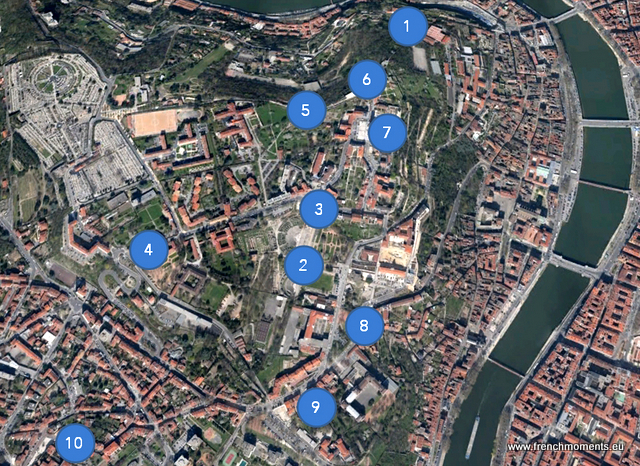
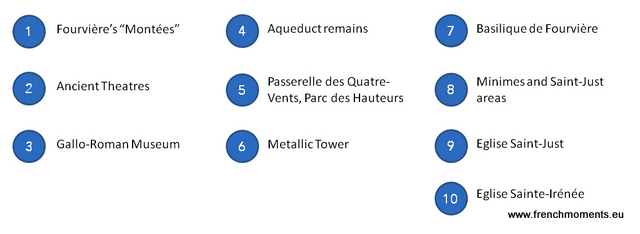
The Montées (Slopes) of Fourvière
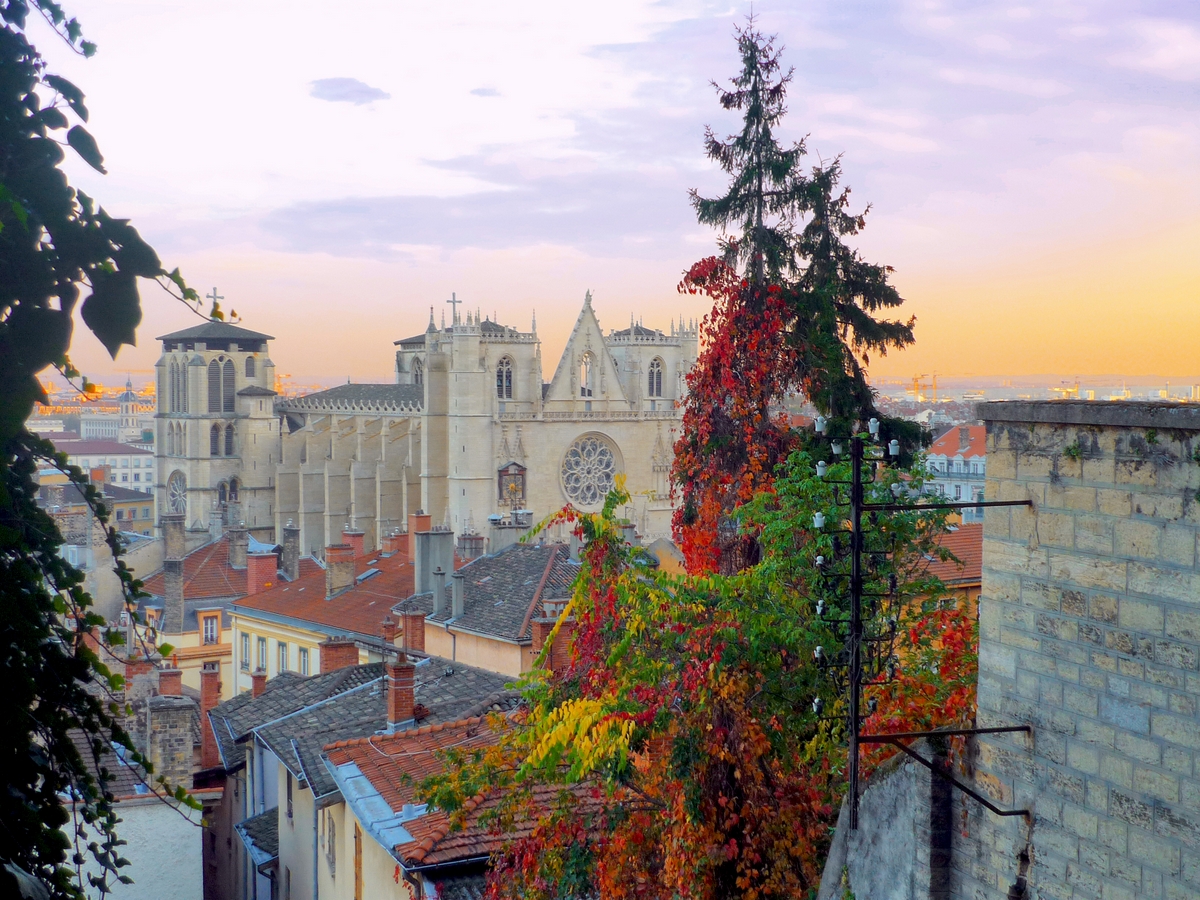
If you want to walk to Fourvière Hill from Lyon Presqu’île, you must first reach Lyon Old Town (le Vieux-Lyon), on the right bank of the Saône River. You must be ready to face one of Fourvière Hill’s famous “Montées” (slopes) from here.
Several rises link different parts of the “Vieux-Lyon” to Fourvière Hill; some of them are stairs. The longest one is the Montée des Carmes-Déchaussées, combined with the Montée Nicolas de Lange. You must use them if you want to join Fourvière Basilica from the Saint-Paul area in the northern part of the old town.
But you had better be ready to climb their 798 steps! You can also go through the Montée des Chazeaux, which links the central part of Fourvière Hill to the Saint-Jean district in Lyon Old Town. Even if quite short (228 steps!), it remains a challenging climb.
However, the view from the top is worth the effort. You can have an overview of the Vieux-Lyon area, especially of Lyon Cathedral, up to the Saône banks.
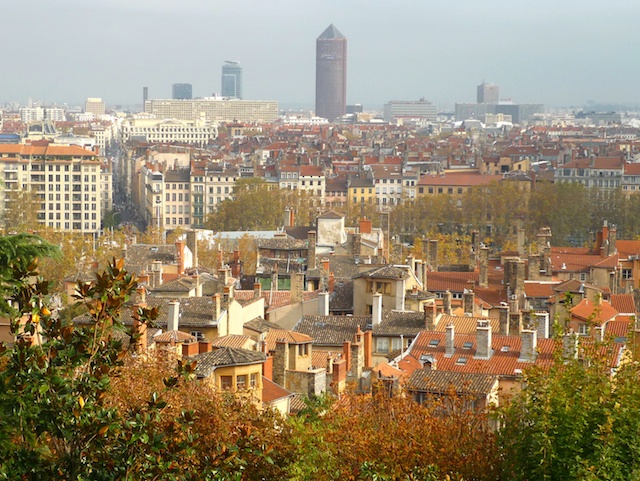
Nowadays, the slopes are secure and easily accessible. However, that was not always the case, especially when Lyon’s municipality abandoned Lyon Old Town in the first half of the 20th century. On November 13, 1930, some buildings collapsed, and 40 people died because of a mudslide on the Montée du Chemin-Neuf. Thanks to the restoration of the Vieux-Lyon area, everything is now secure, and you can enjoy lookouts over the whole city of Lyon from the slopes.
If you do not like climbing, you can access Fourvière Hill more quickly. You can use the funicular railway, which scales Fourvière slopes to get to the top. You can take the funicular after reaching the “Vieux-Lyon” underground station on Lyon’s metro D line.
The funicular goes to two locations on Fourvière Hill.
- The “Fourvière” line has taken people to the main part of the hill, close to the basilica, since 1900.
- The “Saint-Just” line has linked the Old Town to the Southern part of the hill since 1878, with a first stop close to the ancient Roman theatres.
Site Archéologique de Fourvière
(Fourvière Archaeological Park)
Fourvière Hill was the first part of Lyon (back then called Lugdunum) to be settled and developed. Many remains of the town from the Roman era can be seen and visited there.


The theatres of Fourvière
The most famous sites are the ancient theatre and the Odeon of Lyon. Both of these buildings form a pair that is almost unique in ancient Gaul. The same configuration can only be seen in the French city of Vienne, located 30 kilometres to the South of Lyon.
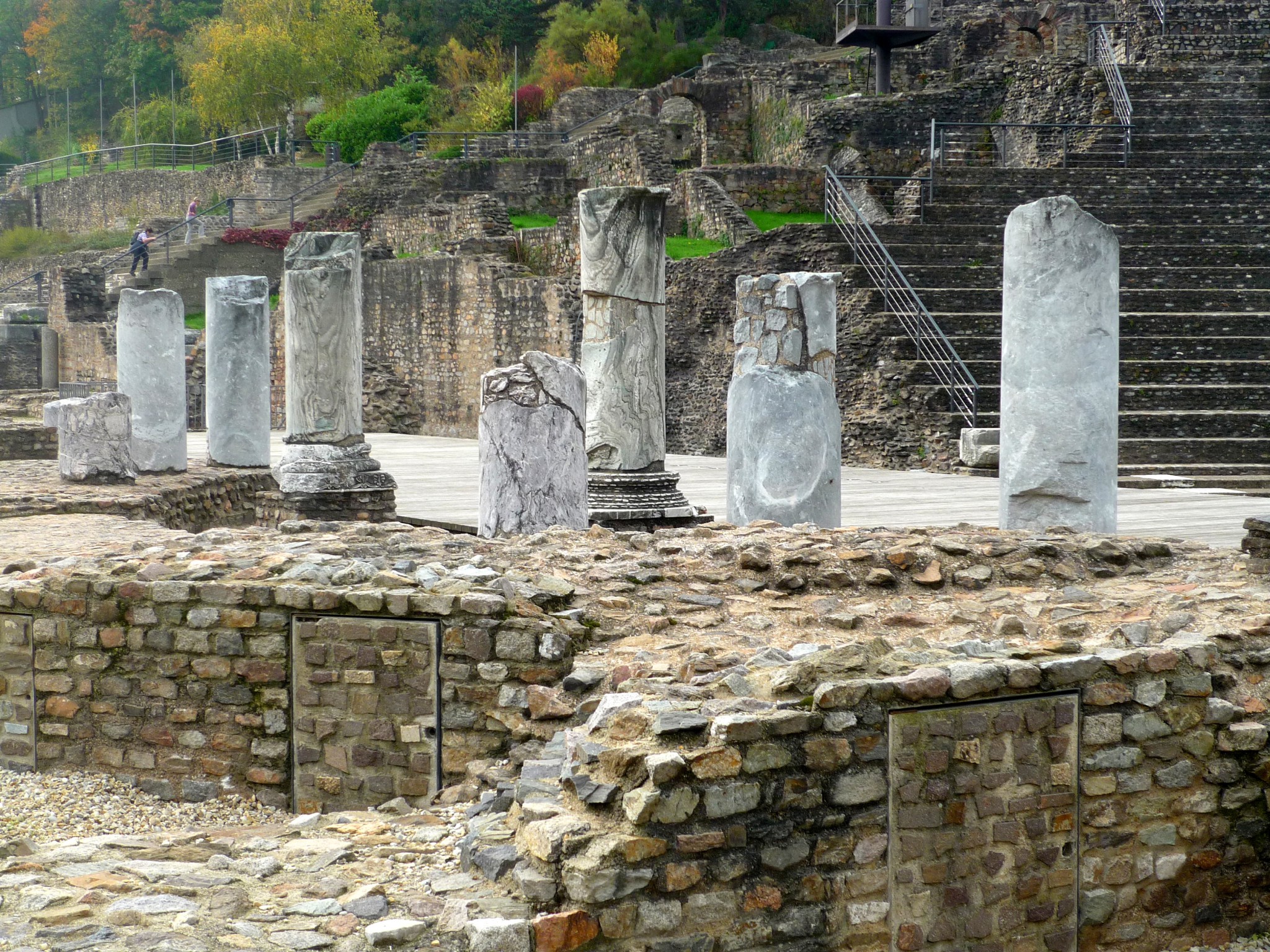
The theatre and the Odeon are part of Fourvière’s archaeological park. You can enter the park from the North on Rue Cléberg or the South on Rue de l’Antiquaille. The ancient theatres are part of a Roman district you can visit. The first official excavations took place in 1933.
They aimed to find the ancient amphitheatre where Christian martyrs were killed in 177. Since then, the excavations have revealed much information to historians, who have found streets, shops and several buildings from the Roman era. For example, they discovered that the amphitheatre did not stand on Fourvière Hill but on another hill in Lyon, today named Croix-Rousse.
A Roman Palace
For years, it was widely thought that a temple dedicated to the Roman goddess Cybele stood on Fourvière Hill.
However, thanks to recent excavations, historians have discovered this was wrong. Archaeologists now think the monumental building that used to stand above the theatre was the palace of Marcus Vipsanius Agrippa.
This Roman statesman was important in Lyon’s history. He created the “Via Agrippa”, a Roman road network, of which Lyon was the centre.
Next to it, archaeologists found the remains of an ancient reservoir part of the Lugdunum aqueduct network. In the 2nd century, it was a 26-metre long and 9-metre wide tank used to stock and clean the water brought to Fourvière Hill from the cities to the West of Lugdunum.

The excavations of ancient theatres
Finally, the excavations led to the discovery of ancient theatres. The Fourvière ancient theatre was built in two stages. Construction was initiated around 15 BC when Augustus was the Roman emperor. Initially, the theatre was relatively small, with a diameter of 89 metres. It was made with stones from the quarries of Glanum, a fortified town on the outskirts of Saint-Rémy-de-Provence.
The theatre was extended in the 2nd century AD thanks to Emperor Hadrian. The diameter was increased to 109 metres. Its capacity was doubled, from 5,000 to 10,000 spectators. The background wall of the stage was erected. The orchestra floor was rebuilt. It was 46 metres long and 3.8 metres wide. It was used to fix the curtain, signalling the performance’s beginning or end. At the entrance, thirty columns create a gate. Nowadays, only the foundations of the background wall remain. However, the mechanism of the under-stage area was intact when discovered by the archaeologists. It is now exhibited in the nearby Roman Civilisation Museum.
The Odeon
Next to the theatre, the Odeon was built in the 2nd century. Even though it is still not clear, archaeologists think it was constructed while the nearby theatre was refurbished and extended. The Odeon is quite similar in shape to the theatre.
However, it is far smaller, with a diameter of 73 metres. So far, only twenty Odeons have been discovered throughout the Roman empire. Unlike the theatre, the Odeon building was only used for musical performances and conferences.
The Odeon was dedicated to the elite of Lugdunum. It might have been covered, according to the archaeologists’ interpretation of the thickness of the Odeon’s bailey.
Like other ancient theatres in Orange or Vienne, Lyon’s theatre and Odeon are the setting for performances.
Since 1946, a festival has taken place in these buildings every summer. The festival is named “Les Nuits de Fourvière” (Fourvière Night Festival). In June and July, around 60 performances brought together more than 130,000 spectators in 2012.
Various types of arts are involved, including theatre, opera and dance. Pop music concerts also occur during the festival, which welcomes many famous French and international singers yearly. During the festival, Bob Dylan, David Bowie, Sting, Charles Aznavour, Juliette Gréco and Vanessa Paradis performed in the ancient theatre.
Musée Gallo-Romain de Lyon-Fourvière
(Lyon Fourvière Museum of Gallo-Roman civilization)
The Lyon Fourvière Museum of Gallo-Roman civilisation was opened in 1975. It is located next to the ancient theatres to the North. The museum aims to preserve and exhibit the remains from the Roman era found by archaeologists in and around Lyon.
To preserve the archaeological site, the architect Bernard Zehrfuss was asked to create a museum that would fit in with its environment. The architect imagined a buried construction.
The result is surprising: walking around the archaeological site, you almost cannot notice the museum. Only two bay windows called “canons à lumière” (light cannons), allow the museum’s visitors to enjoy the view of the theatres while visiting the exhibition spaces. Those seventeen spaces were devoted to Lyon’s daily life during the Roman era.
You can see craftsmen working tools among the objects, but there are also more institutional items, such as a transcription of Lugdunum-born Emperor Claude’s speech on equal rights. The speech was carved into bronze and discovered in 1528 by a draper. This speech gave Gaul’s citizens the same rights (and duties) as those in the Roman Empire. Temporary exhibitions also occur in the museum, which has become a landmark in Lyon.
Remains of Lyon’s ancient aqueducts
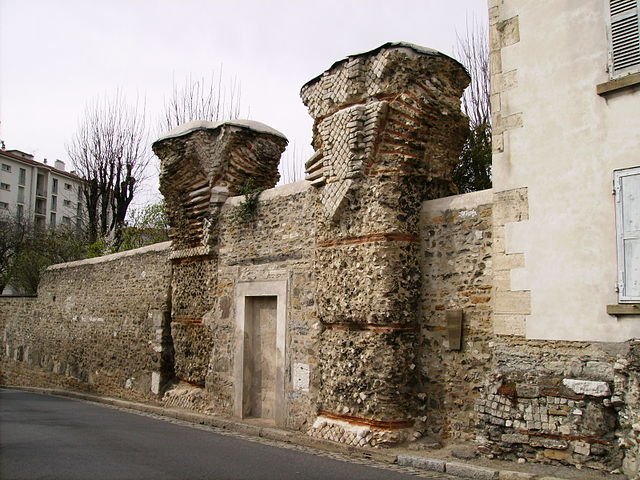
Aqueducts were already used throughout the Roman Empire. It was not something new to build new ones in Lugdunum. However, it was pretty difficult because the area was hilly. Contrary to some other flat places, the water had to go down and climb up to reach Fourvière Hill’s living areas.
For instance, water in one of the aqueducts (the Gier aqueduct) had to climb 176 metres to reach the top of Fourvière Hill from the Yzeron Valley.
Bringing water from the valley to the hill was challenging for Roman architects. Siphons were created. The water is left from an upright-located reservoir. Then, it went down due to atmospheric pressure, so water could pick up speed and climb up to its final stop in another reservoir.
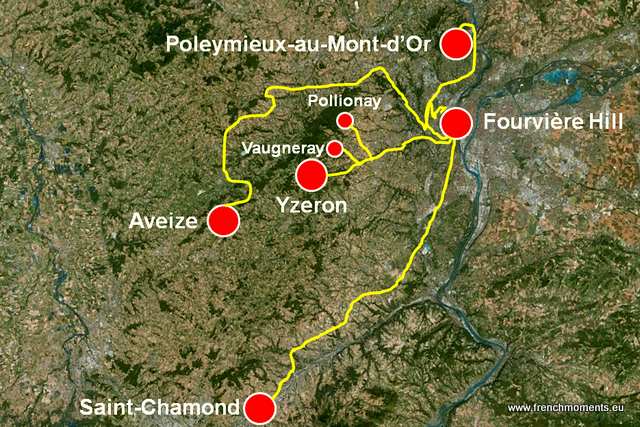
Four aqueducts to bring water to Lugdunum
According to archaeologists and historians, four aqueducts were built to bring water to Lugdunum.
- The “Aqueduc des Monts d’Or” (Golden Mounts Aqueduct) was built around 20 BC on the orders of Marcus Vipsianius Agrippa. It was 26 kilometres long, including 22 kilometres that were buried. It started from a stream called the Thou and arrived at Southern Fourvière Hill in the Minimes area.
- The “Aqueduc de l’Yzeron” was constructed around 9 BC. It went from today’s western suburb of Yzeron in Lyon to the Point-du-Jour area, southwest of Fourvière Hill. The Yzeron aqueduct was unique because it had various sources. The pipes met in Craponne, about eight kilometres west of Lugdunum.
- The “Aqueduc de la Brévenne” dates from the beginning of the 1st century AD. Its water output might have been up to 324 litres per second, making the Brévenne aqueduct’s most powerful one in Lugdunum.
- Finally, the “Aqueduc du Gier” was built around 130 AD. It is the longest of Lugdunum’s aqueducts, 86 kilometres from Saint-Chamond to Lyon’s south-west. Many remains are left from this aqueduct, especially in Chaponost, in Lyon’s western suburbs.
In the Fourvière area, you can see a few remains of the Aqueduc du Gier, at the end of Rue Roger Radisson. This street used to be the Via Aquitania, which left Lugdunum to reach western Gaul. Those remains, which are just next to houses, were ranked as historical monuments in 1964.
Parc des Hauteurs
From the archaeological park of Lyon Fourvière, you can easily reach the other main area of the hill, around the basilica and the Parc des Hauteurs, a promenade on Fourvière Heights.
The Parc des Hauteurs project is relatively recent: it was created in 1989. Back then, Lyon’s municipality sought to preserve and enrich Fourvière Heights. They believed that Lyon was lucky to have developed around Fourvière Hill, which was (and still is) a historical site that did not suffer damage from intense human activity during the industrialisation era.
To promote this area, it was decided to build a promenade that would allow people to stroll from the eastern part of Fourvière Hill (Loyasse cemetery) to the right bank of the Saône in Lyon Old Town. While walking along this promenade, people would come across places such as the Basilica, the Metallic Tower, Fourvière slopes and the Old Town.
Jardin du Rosaire
Let’s start with the Jardin du Rosaire, the western part of the Parc des Hauteurs. You can enter the Garden from Lyon Old Town’s Montée Saint-Barthélémy (St. Bartholomew slope).
The Garden comprises lovely pathways that climb up to Fourvière Basilica, surrounded by bushes and trees.
There are lookouts over the city of Lyon and Croix-Rousse Hill and the Chevet of the Basilica. Along the walk, several small gardens are devoted to different flowers or architectures: Garden of the Roses, Chinese Garden, Coloured Garden…
Walking in the Jardin du Rosaire is an enjoyable stroll, especially during summer: the trees around the pathways bring shade and make the walk quite cool when it’s too warm in town! The walk through Jardin du Rosaire will bring you to Fourvière Esplanade, from where you can visit the archaeological park going to the South.
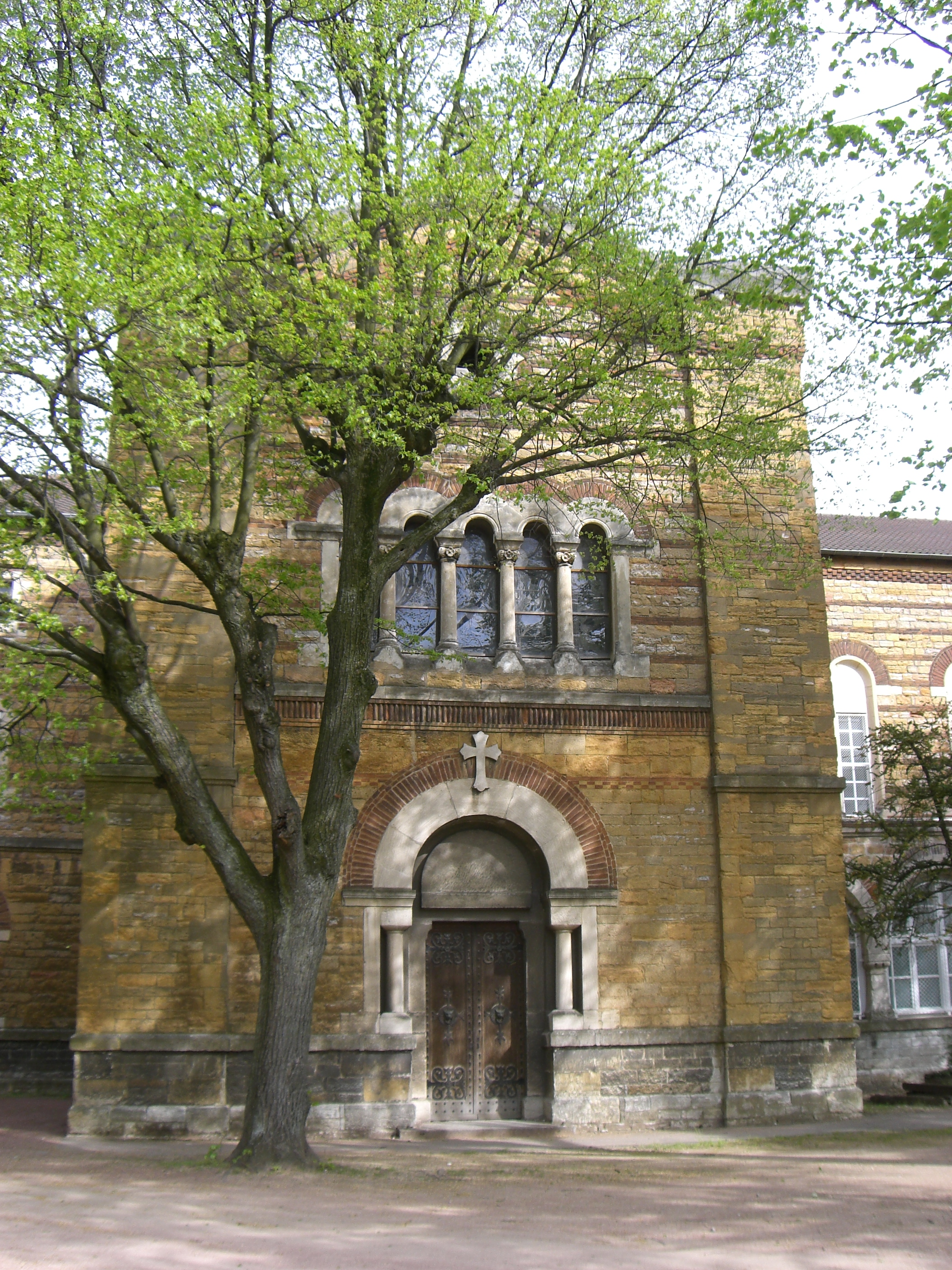
Jardin de la Visitation
Then, you can continue your journey through the Parc des Hauteurs, visiting the Jardin de la Visitation (Visitation Garden).
The garden is named after the Order of the Visitation of the Holy Mary, a Roman Catholic religious order intended for women.
The “Visitandines” acquired a part of the area in the 1850s to build a new convent after having fled from Croix-Rousse Hill because of the Canuts’ riots. The cloister was built following plans by architect Pierre Bossan, whose sister was part of the Order of the Visitation.
This is one of Bossan’s first works in Lyon, eighteen years before he started working on Notre-Dame de Fourvière Basilica.
The convent was transformed for decades until the beginning of the twentieth century. Then, the nuns faced financial problems, which were also the consequence of the introduction of French secularism in 1905. In 1965, the convent was eventually sold to the Lyon Municipality.
After considering turning the convent into a school of architecture, the building was finally rented to the civil hospices of Lyon to become their record office.
Originally laid out by the nuns, the park of the cloister is now public. It is a nice place to visit as it is tranquil and peaceful. You can enjoy a beautiful view over the Odeon of Lyon and Southern Presqu’île there.

Passerelle des Quatre-Vents
After strolling through the Visitation Gardens, you can continue your journey through the Parc des Hauteurs on Rue Pauline-Marie Jacot to the Loyasse Cemetery. From there, turn right on Chemin du Viaduc (Viaduct lane), which leads to the Passerelle des Quatre-Vents (Belvedere Footbridge).
The 72-metre-long footbridge was a viaduct part of the tramway line that linked Loyasse Cemetery to Fourvière Esplanade.
Only 800 metres long, it was the shortest tramway line in France before it was destroyed in 1952. The footbridge was built in 1993 where the former viaduct used to stand. It was designed by architect Manuelle Gontrand and engineer Marc Malinowski before landscaping by Michel Desvigne and Christine Dalnoky.
The footbridge has quickly become one of the most famous lookouts in Lyon. From there, you can see Fourvière Metallic Tower and Basilica on the one side and Croix-Rousse Hill on the other. The footbridge ends on an impressive Metallic structure: the Fourvière Metallic Tower.
Tour métallique de Fourvière
(Fourvière Metallic Tower)

When you see the Metallic Tower of Fourvière, you can’t help thinking about another famous steel-made French building… the Eiffel Tower! However, the two buildings do not have anything in common. If Gustave Eiffel had not made the Fourvière Metallic Tower, its shape would be very close to the Paris building’s third and final floor.
However, the tower in Lyon is far smaller since it is only 86 metres high, compared to the Eiffel Tower at 324 metres.
Fourvière Metallic Tower was built a few years after the Eiffel Tower (1887-1889), in 1893 and 1894. It was built for the 1914 World Fair, which took place in Lyon.
Back then, there was a restaurant on the ground floor of the tower, as well as an elevator which could take up to 22 people to the top of the building to enjoy the view over Lyon.
In 1953, the Tower was bought by the RTF (the French national agency which brought radio and television to the public) from the previous owners, a family from Lyon.
The tower, the high point of Lyon, ceased being an observation point and has been used as a television transmitter since 1963. Consequently, the restaurant closed, and the whole tower has been closed to the public since then.
Basilique Notre-Dame de Fourvière
(Our Lady of Fourvière Basilica)
From the Passerelle des Quatre-Vents and Fourvière Metallic Tower, you can quickly join the Fourvière Basilica esplanade, a few metres away to the south.
The esplanade used to be the ancient Roman forum called Forum Vetus. This name evolved into “Fourvière”.
In the forecourt of the Basilica stands a statue of Pope John Paul II, erected in 2011, twenty-five years after the Pope visited Lyon.
The statue by Elisabeth Cibot is made of bronze, is 4.5 metres high and weighs more than seven tons. It looks at the city of Lyon with the Pope’s arms open, reproducing John Paul II’s stance while blessing Lyon in 1986.

The gilded statue of the Virgin Mary
On 8 December 1852 (during the feast of the Immaculate Conception), a gilded statue of the Virgin Mary was erected at the top of the 12th-century Fourvière Chapel, which had just received a new bell tower.
The new statue was meant to overlook the whole city to symbolise the Virgin’s protection over Lyon. On that day, a ceremony began to bless the statue and the new bell tower. The people of Lyon quite spontaneously placed candles in their windows to honour the Virgin Mary. This tradition originated from the Lyon Festival of Lights, which occurs every year on 8 December.

The Basilica of Fourvière: an imposing monument
Next to that chapel, the Basilica is a massive 19th-century building.
When you go to Lyon, you simply cannot miss the Basilica, which can be seen from many places in the city, such as the Rhône banks or Place Bellecour. Its position on the top of Fourvière Hill enables the Basilica to overlook the city of Lyon. People from Lyon are used to this silhouette, which many consider protective and benevolent.
A dedication to the Virgin Mary
Fourvière Basilica has been dedicated to the Virgin Mary, who has been the protectress of Lyon for centuries.
Before the Basilica was built, a few dates endeared the people of Lyon to the Holy Mary. The first one was in 1643 when the plague spread and threatened the region of Lyon.
The city council’s aldermen dedicated the city to the Virgin Mary to stop the plague epidemic. They made a solemn promise: every year, they would pilgrimage to the top of Fourvière Hill if the city was freed from the plague. They would offer the Virgin a gold écu coin and a 7-kilo candle there.
The epidemic eventually ended and left the town: the “Vœu des échevins” (the aldermen’s vow) was answered. Since then, the vow has been repeated every year on 8 September (the day of the Virgin Mary’s Nativity feast) during a Mass at Fourvière Basilica by Lyon’s archbishop, in the presence of Lyon’s mayor and city councillors.
The origins of the construction
However, the origin of the Basilica’s construction dates from a few years later, in 1870, when France faced the Franco-Prussian war.
Lyon citizens prayed to the Virgin Mary to protect the city so that the war would not reach Lyon. Lyon’s archbishop, Jacques-Marie-Achille Ginoulhiac, promised to build a new sanctuary dedicated to worshipping the Virgin Mary if the Prussians did not invade the city.
Once again, the prayer was answered, and the Basilica was built. To finance the building, many people of Lyon gave sums of money or even jewels, which led to the foundation stone being laid in 1872.
The architect was Pierre Bossan, who had already designed the “Visitandines” Cloister on Fourvière Hill. Both Romanesque and Byzantine architecture inspired him. After his death, the work was carried on by architect Sainte-Marie Perrin.
Four octagonal towers
The Basilica can be easily recognised from the outside by its four octagonal towers, which rise to 49 metres and symbolise the cardinal virtues.
The north-east tower represents prudence, the north-west tower depicts strength, the south-west tower personifies justice and the south-east one temperance.
That tower is said to be subjected to a curse: from 1889 to 1919, four different bells were installed at her top. The first one was too big and did not fit! The second could not be tied down, and the third was split. Finally, the fourth bell was installed in 1895. It worked until 1919 when its sound suddenly changed! Since then, there has been no bell on the south-east tower of the Basilica. The two eastern towers can be climbed.
The northeast tower has an observation platform made of lava stone. Being one of Lyon’s highest points, it offers one of the most beautiful views over Lyon.

The northern front
The northern front represents allegories of faith, hope and charity.
On the 35-metre-long facade, the main portico is composed of three arches.
Above it is a gallery representing twelve figures from Lyon’s 19th century.
The actual doors of the church are made of bronze. From left to right: Jules-Emile Planchon (a botanist), Lucien Brun, Antoine Frapet (two aldermen), Prosper Dugas (a banker), Alphonse de Boissieu (a writer), Laurent-Paul Brac de la Perrière (a lawyer who helped fund the construction of the Basilica), Pierre-Hector Couillé, Louis-Marie Caverot, Jacques-Marie-Achille Ginoulhiac, Louis-Jacques-Maurice de Bonald (five archbishops of Lyon) and Pierre Bossan, the architect of the Basilica who died a few years before the actual inauguration of the church.
Above the gallery, the Virgin Mary is represented by Archangels Gabriel (on her left) and Michel (on her right). The triangle at the top symbolises the aldermen’s vow to free the city from the plague in 1643. At the bottom of the façade, the Lion of Judah, which Charles Dufraine sculpted, guards the entrance of the Basilica’s crypt.
The crypt
The crypt is the darkest part of the Basilica and is quite understated. It is dedicated to St Joseph, a Pierre Bossan wish.
It is less than ten metres high, which gives an impression of simplicity. The architect wanted visitors to enter the church first by going to the crypt: they would be in a pretty simple place before reaching the impressiveness of the upper church.
The high altar’s ornamental tiling represents the Seven Deadly Vices: pride is depicted as a peacock, sloth as a tortoise, lust as a ram, envy as a snake, evil as a seven-headed dragon, wrath as a cat, and greed as ants dragging a fly. The high altar statue depicts St Joseph with Child. The sculpture was made by Joseph-Hugues Fabisch, who represented St Joseph’s face using Pierre Bossan’s.
Inside the church
The interior of the upper church is stunning: the rich decoration jumps out.
The primary colour is blue, which is the colour of the Virgin Mary, and gold is also dominant in the church’s interior, especially in the mosaics by Charles Lameire and Georges Décote. The glass windows are also impressive, being exceptionally luminous.
The church is divided into three naves, above which three cupolas depict the Virgin Mary and the Holy Trinity.
Meanwhile, Mary’s earthly life is represented in the chapels, the Virgin in France and the World is depicted on the mosaics and her Queenship on the glass windows.
Six brass ceiling lights were installed during the last restoration of the Basilica, which was completed in 2013. Each weighs more than 500 kilos, allowing visitors to notice some of the details of the mosaics. In the apse stands a stunning statue of the Virgin by Paul-Emile Millefaut, made of Carrara marble.
St. Thomas Chapel
The Chapelle Saint-Thomas (St. Thomas Chapel) is located next to the Basilica to the north.
It is dedicated to the Virgin Mary and St Thomas of Canterbury and is Fourvière Hill’s original chapel, first built in the 12th century.
It was destroyed by the Huguenots in 1552, during the Wars of Religion, before being rebuilt at the end of the 17th century. Pilgrims visit the chapel to see its 16th-century Black Virgin. Its bell tower was enlarged in 1852 to welcome the famous gilded statue of the Virgin Mary by Joseph-Hugues Fabisch.
Quartiers Minimes et Saint-Just
(Minims and St. Just areas)
The Southern part of Fourvière Hill, with Minimes and St Just areas, is quite interesting. You can go back to the eastern entrance of the Archaeological Park, on Rue de l’Antiquaille, which marks the entrance of the Minimes area.
The district’s name refers to the Minims, a Catholic religious order founded in the 15th century whose members wanted to live effortless lives. If you go down Rue de l’Antiquaille, you will have Place des Minimes (Minims Square) on your left and the Collège Jean Moulin (Jean Moulin secondary school) on your right, built on ancient Roman remains.
The Roman public baths
Next to it, archaeologists discovered remains of the ancient Lugdunum Roman thermae (public baths), which were accessible to the public by going under the arches of the block of flats next to the school (6, rue des Farges).
As the school was built on parts of the public baths, only the southern remains could be found by archaeologists.
Still, we know quite a lot about this Roman construction from 50 AD, which was extended a hundred years later. The area was made of three patios. The upper ones were bordered with stores and large houses which belonged to the wealthiest men in Lugdunum. The lower patio was only bordered by stores. It became the Palaestra (an esplanade where events such as boxing and wrestling occurred) of Lyon Fourvière after the construction of the Thermae.
The public baths were 75 metres long and 55 metres wide and composed of eight underground rooms. They were initially accessible to anybody, without distinction of any kind, such as legal status, social class, or sex, but Emperor Hadrian forbade mixed baths at around 130.
Parts of the remains have been restored and are now accessible to the public, namely the southern sections of the public baths and a part of the Palaestra. If you want to know what the place looked like two thousand years ago, you should visit the Gallo-Roman Museum of Fourvière: a reconstructed model of the area has been created thanks to the information from the archaeologists’ excavations.
Lycée Saint-Just
In front of the block of flats where the remains of the public baths are “hidden”, you can see a massive building from the 19th century, which overlooks the city of Lyon.
Now a public high school called Lycée Saint-Just, it was built between 1855 and 1861 and was originally a seminary. The building has a one-hundred-metre-long main section with two wings on its sides.
Being quite monumental, the construction cost a lot of money, and French emperor Napoleon III once said, “I said to build a seminary, not to build a palace!”.
In 1912, seven years after the establishment of French secularism, the building became an office of the French Consignment and Loans Fund (“Caisse des Dépôts et des Consignations”). It was a hospital during World War I. At the end of the 1920s, it was redeveloped into a boarding school, which became independent after World War II with its current name: “Lycée Saint-Just”.
Nowadays, it is one of the most renowned high schools in Lyon since the students are very successful at national examinations such as “le baccalauréat”.
Grotte Berelle
The place is also surprising because it was built on an ancient Gallo-Roman grotto, which used to be a reservoir during the Roman era of Lugdunum and is called “Grotte Berelle”.
It could hoard up to 440,000 litres of water from the Yzeron Aqueduct but has not been used since the end of the Roman era. It even “disappeared” when the Lycée Saint-Just was built on it before being rediscovered in the 1920s thanks to excavations.
Now closed to the public, archaeologists and historians can still visit the grotto, helping them learn much about how the Romans could store the water from the aqueducts.
Hopital de l’Antiquaille
To the north of Place des Minimes, massive buildings used to be a convent and became a hospital in the early 19th century called “Hôpital de l’Antiquaille”. Being just next to the Roman theatres (just on the other side of the street, next to the Rue de l’Antiquaille Archaeological Park’s entrance), wealthy Roman property owners used to live there.
More than a thousand years after the end of the Roman era, a bourgeois from Lyon constructed a beautiful manor he called “l’Antiquaille”, referring to the numerous remains from Antiquity that were found there.
In the 17th century, the building was bought by the “Visitandines” from the Catholic religious Order of the Visitation of Holy Mary and was extended. A cloister, a chapel and new wings were constructed, but the nuns had to leave in 1792 during the French Revolution.
The hospital replaced the convent, and its original mission was to help the homeless people of Lyon.
However, it became more universal by the end of the 19th century. It started being an essential place for medical research in France, making the Antiquaille Hospital one of the most important in Lyon.
Being relatively far away from the other hospitals in town (most of them are located on the left bank of the Rhône, in eastern Lyon), it was closed in 2003 after having been bought by a private construction company.
The building has been refurbished for almost ten years and turned into apartments and hotel rooms. The refurbishment project also includes opening a museum that tells the history of Christianity in Lyon, which opened during the summer of 2013.
A restaurant with a view!
Next to the former Antiquaille Hospital, on Rue Pierre Marion and Montée du Chemin Neuf, is a restaurant whose Chef is Christian Tetedoie. He has been ranked as “Meilleur Ouvrier de France” since 1998, a distinction bestowed upon the best craftsmen in France.
The restaurant has been ranked with one star in the “Guide Michelin” since 2000, making it one of the best places to eat in Lyon.
It is unique, thanks to the amazing view from the dining room over the city of Lyon. You can even see the Alps and Mont-Blanc on a fine clear day. In fact, the Minimes area is one of the best places on Fourvière Hill to enjoy views of the whole town. On Rue Pierre Marion, there are several spots where you can enjoy amazing views over the city.
Eglise Saint-Just
(St. Just church)
At the south of the main part of Fourvière Hill (around the Basilica and the Archaeological Park), there are still interesting places to see and visit, especially two churches called Saint-Just and Saint-Irénée (St. Irenaeus). Those churches reflect the powerful influence of Christianity on Fourvière Hill’s architecture.
At the end of Antiquity, the Église Saint-Just was initially constructed in the 5th century. The original St. Just Basilica was first dedicated to the Maccabées (Holy Maccabean Martyrs), referring to a Jewish Family who lived in the 2nd century BC.
Also known as the Women with Seven Sons, they were executed in Palestine by the King of Syria for having refused to eat pork.
St. Just
The Basilica was also dedicated to St Just, a Lyon bishop in the 4th century AD.
One day, a madman who had killed several people in Lyon took refuge in the Bishop’s cathedral after having been chased by citizens. However, the man’s hiding place was soon discovered, and the crowd went crazy as they wanted to avenge their fellow citizens’ deaths.
To calm them down, St Just accepted the task of asking the madman to leave the cathedral and hand him over to a magistrate if the crowd did not hurt him.
However, when the man got out of the building, he was lynched by the crowd. These events deeply affected the bishop, who resigned and flew from Lyon to Egypt, where he died in 390.
When the people of Lyon learnt of his death, they went to Egypt to fetch his body back to the city. They buried St Just’s body in a mausoleum in the Holy Maccabean Martyrs Basilica, which became St Just Basilica.
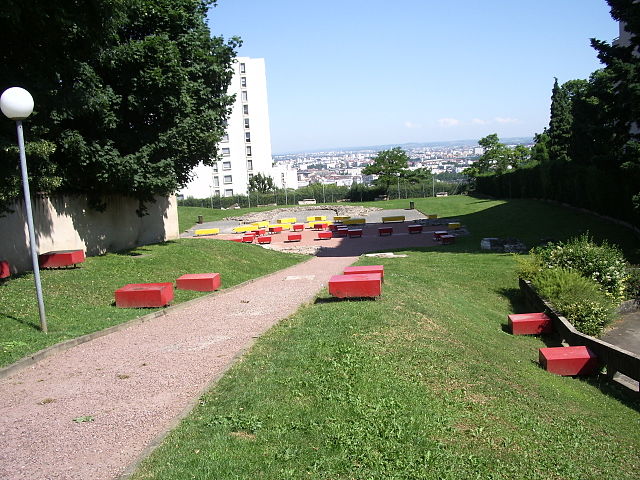
The history of the church
The old Basilica was extended and refurbished several times until the 16th century, especially during the 5th and 12th centuries. It had even become the second biggest church in Lyon, right after Lyon’s St Jean Cathedral. However, the building was destroyed in 1562 during the Wars of Religion.
Archaeologists discovered remains from the old Basilica in the 1970s, bought by Lyon’s municipality. Red and yellow blocks were placed where the old churches used to stand before being destroyed.
After being destroyed, St Just Church was rebuilt about 200 metres away from the original, where a Roman necropolis used to stand.

The construction of the current building started in 1565 and lasted for almost a century until 1663.
The neoclassical Jesuit façade was added in the early 18th century and was designed by Ferdinand-Sigismond Delamonce.
A consecration in Latin was sculpted on the façade: “Machabaris primo deinde sancto ivsto” (First to the Maccabeans, then to St Just) and two statues depicting St Just and St Irenaeus stand on each side of the church front.
The building was damaged during the French Revolution, and forty years passed before Joseph-Jean-Pascal Gay refurbished St Just Church. Inside, we can see many paintings from the 18th century, mosaics and glass windows that especially depict the Virgin Mary and St Just.
Nowadays, the Church is a historical monument from 1980, and it is not used much for Christian ceremonies. However, it frequently welcomes sacred music concerts, thanks to the building’s large choir gallery and extraordinary acoustics.
Église Saint-Irénée
(St Irenaeus church)
Like the Église Saint-Just, the Église Saint-Irénée was first built in the 5th century, also on a Roman burial ground.
Two Christian martyrs of Lyon, Alexandre and Épipode, who had been tortured and executed in 177 in the Three Gauls Amphitheater on Croix-Rousse Hill, had been buried there.
A trace of that burial ground can still be seen today in the north wall of the current church.
St. Irénée
St Irénée (St Irenaeus) was Lyon’s second bishop: he came after St Pothin, one of Lyon’s Christian martyrs, in 177. He was a theologian and contributed to founding the Christian Community of Lyon.
Despite doubt about these facts, historians often consider he died a martyr in 202. His mortal remains were buried along with other Christian martyrs of Lyon, where the current Église Saint-Irénée now stands.
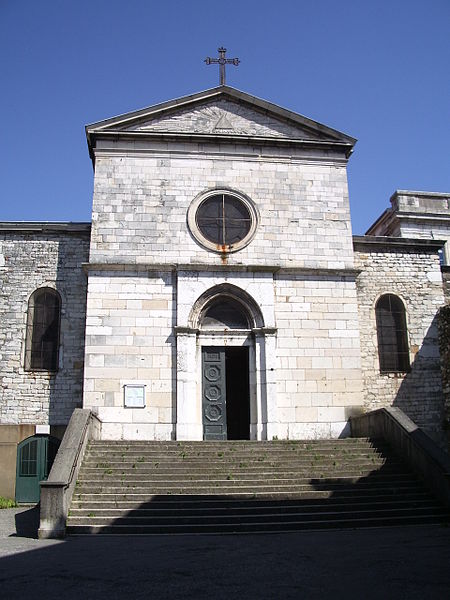
In the 5th century, a sanctuary dedicated to St John was built above the Christian martyrs’ crypt. After facing many tribulations, the church was eventually destroyed and rebuilt in the 9th century, although the crypt remained.
From the 10th century, the church has been dedicated to St Irénée.
Like St Just’s Church, the Église Sainte-Irénée was extensively damaged by the Protestants in 1562 during the Wars of Religion. The upper part of the church was totally destroyed, while the crypt suffered damage, especially the Christian martyrs’ bodies that were buried there.
The upper church was identically rebuilt in 1584, whereas the crypt was only restored in the 18th century.
After the French Revolution, the church started to collapse: most of the building had to be restored, while some parts were completely rebuilt in a neoclassical style between 1824 and 1830 by Lyon architects Louis-Céline Flacheron and Claude-Anthelme Benoît. As for the crypt, it was restored by Tony Desjardins in the 1860s.
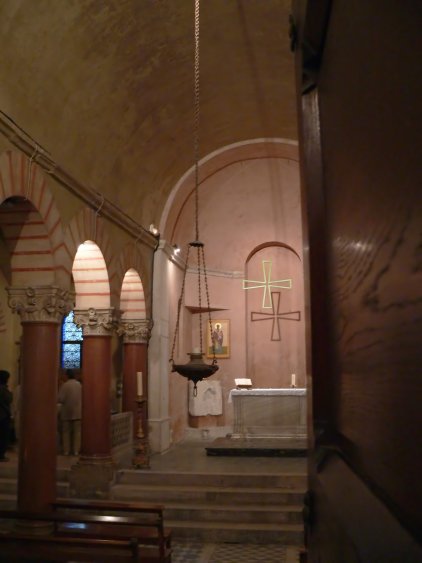
Inside the church
A few Christian funerary writings from the 4th century remain on the crypt’s walls.
In the centre of the nave stands the “Puits des Martyrs” (Martyrs’ well), where the remains of the Lyon martyrs would have been resting before the crypt was damaged in 1562. The people of Lyon considered the soil from the well sacred and miraculous for treating incurable diseases.
In the centre of the choir, you can see a piece of white marble, which is thought to be the former St Irénée’s gravestone. The upper church is decorated with statues and glass windows from the 19th and 20th centuries, which depict the early years of the Christians in Lyon.
These works represent the martyrs of the 2nd century, including Holy Blandine and St. Irénée himself. The upper church and the crypt were ranked as historical monuments in 1862.
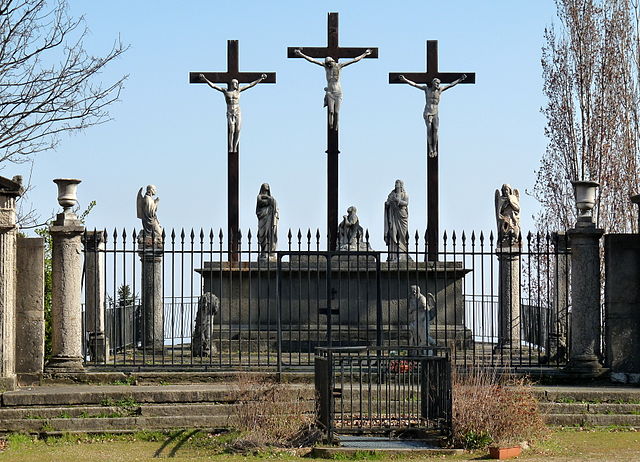
Finally, outside the church and behind its chevet, there is a calvary monument that dates back to the 17th century. An underground chapel is located next to it but is closed to the public. It was destroyed in 1793, during the French Revolution, but was rebuilt in the 19th century, and the area became the Stations of the Cross. The Calvary monument is located west of the church, so it overlooks the city of Lyon. Nowadays, it is one of the few monuments of its kind in the main city of France.
Things to do in Lyon
Looking for special and unique things to do in Lyon? Here are a few ideas:
- An Electric Ride in Lyon
- A Segway Tour of the Historic Centre of Lyon
- A Segway Tour of the Parc de la Tête d’Or
- A Dinner Cruise on the Hermès Barge in Lyon
- A Workshop and Street Art Walk around the Croix-Rousse District
- A Commented Cruise on a Barge in Lyon
For more activities and things to do in Lyon, check out the following offers:
English-French Vocabulary
(f) for féminin, (m) for masculin, (adj) for adjectives and (v) for verbs
- altar = autel (m)
- ancient = antique (adj)
- archbishop = archevêque (m)
- bailey = mur d’enceinte (m)
- bell = cloche (f)
- bishop = évêque (m)
- to bury = enterrer (v)
- cavalry monument = calvaire (m)
- choir = choeur (m)
- church = église (f)
- to climb = grimper (v)
- cloister = cloître (m)
- to collapse = s’effondrer (v)
- craftsman = artisan (m) / ouvrier (m)
- daily life = vie quotidienne (f)
- excavations = fouilles (f)
- to extend = étendre / agrandir (v)
- flat = plat (adj)
- footbridge = passerelle (f)
- forecourt = parvis (m)
- garden = jardin (m)
- gilded = doré (adj)
- glass window = vitrail (m)
- ground floor = rez-de-chaussée (m)
- high point = point culminant (m)
- high school = lycée (m)
- hill = colline (f)
- hilly = valloné (adj)
- to open = ouvrir (v)
- to reach = atteindre (v)
- to refurbish = rénover (v)
- remains = vestiges (m)
- Roman road = voie romaine (f)
- singer = chanteur (m) / chanteuse (f)
- slope = montée (f)
- speech = discours (m)
- stairs = escaliers (m)
- stroll = promenade (f)
- suburb = balieue (f)
- tool = outil (m)
- water = eau (f)



